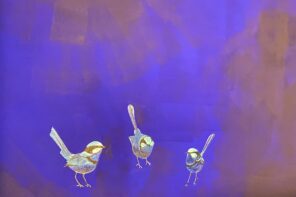All year I have been playing a game without rules.
It started in February. I was in London for a meeting. I’d arrived early, and it was raining so I went to the British Museum. The previous evening I’d witnessed a massive row over dinner between my friend Kit Cavellin and a mutual friend called Magnus Laar. Everyone was so drunk that the argument flared up very quickly. Magnus Laar was adamant that the novel was dead because the characters aren’t real, and Kit Cavellin, a novelist, objected quite strongly, and the rest of us didn’t really mind one way or the other. It ended up with Kit Cavellin losing her temper and informing Magnus Laar that he wasn’t real either. After that we all went home early.
The rain was falling heavily so I was glad of the dry corridors in the Museum and I wandered around for a long time, feeling very hung over and not really caring much if I looked at anything or not. There were scores of people there, clustering around glass cabinets. I meandered into a few great rooms with those sightless alabaster statues that used to terrify me as a child, because it seems probable they will turn at any moment and speak. Why so many statues anyway? I wondered, as I moved through another such room. They’re a childhood nightmare! But that was not quite relevant, I conceded. What was relevant in this place was also quite uncertain, because there was so much of it, ancient objects in one room and then another, with little cards everywhere explaining what on earth was going on. I didn’t pause to read them. But then I saw a cabinet that really piqued my interest.
Inside was a game, without rules. It was played across the Middle East and Mediterranean for thousands of years, from 3000 years before the Christian Era and until the early centuries AD when interest faded, for reasons I didn’t understand. Perhaps people wanted to play a new game. The little card explained that when the game was found no one knew how it was played, because the board survived and the pieces but there was no residual trace of the rules themselves. This begged the further question of whether a game that cannot be played, because there are no known rules, is really a game, or just an ornamental block of wood?
The board was beautifully ornate and covered with shell squares, some of which were decorated with eyes, or rosettes. It was called the Royal Game of Ur, because it was originally found during the excavation of the ancient city of Ur, during the 1920s in modern-day Iraq. Ur was the religious seat of the civilization of Sumer, which predated the Egyptian, Greek and Roman worlds, and produced the earliest mathematical systems and the first poetry, including the Epic of Gilgamesh. There’s a very famous ziggurat there, a pyramid with steps, which is where the game without rules was found. At least, one of the games without rules. There are so many after all…
As for the Royal Game of Ur, there were two sets of playing pieces, and the board is cleverly designed so you could keep your pieces in a drawer in the set itself, so as not to lose them in the marketplace or fields or wherever you were playing. I’ve never been very good at facts and figures, but I was very impressed by how old this game was, and the mysteries surrounding its rules. Some people argued that the playing pieces represented the planets, and that moves on the board afforded prophecies of the future. Similar games were played in Ancient Egypt as well, where it was believed by some that if you prospered in the game then you would have great fortune in the afterlife.
A great and extraordinary man, Dr Irving Finkel of the British Museum, translates cuneiform for a living, which is the oldest writing system in the world. One thing that is quite lucky about Ancient Mesopotamia: the river banks were full of clay. This meant the representatives of this long-gone civilization used clay tablets for their writing, and so museums all over the place are full of clay tablets covered in cuneiform, which is a beautiful system that few people understand. But Irving Finkel can read it fluently, and he can write it as well. He found a clay tablet in the British Museum written by a Babylonian astronomer, which described rules that seemed to relate to the Royal Game of Ur. At the same time, Finkel knew that the Jewish communities of Cochin, India played a similar game for thousands of years and even into the 20th century, and took the game to Israel when they migrated. Finkel asked a relative in Israel to research this further, and an elderly woman called Ruby Daniel confirmed the rules. They were the same rules as the Babylonian astronomer described, the same rules played by long-gone people through millennia, from India to Egypt, from Mesopotamia to Crete, and beyond.
I was very interested in this game and the story around it, and the idea of such a vast array of civilizations playing the same game for thousands of years, the rules passed from one person to another, written on clay tablets or scrawled in the dust, and small perishable pieces, also, passed from one hand to another, as wars raged and catastrophes destroyed great cities, leaving them abandoned, and yet still these games were played. Two players, the object of the game to capture the pieces of your opponent, rolling a dice or knuckle bones, taking turns to move the pieces. The games were lost, perhaps reinvented, passed down. Again and again.
I thought so much about this I almost missed my meeting, which was somehow related. This is one of the strangest things I’ve learned about life, that you can’t tell at first, if at all, how things are related, or if you’ve just related them arbitrarily because you’re determined to relate things, whether they’re related or not. Often you feel as if you are being played in a game, because you’ve been moved into a particular position without realizing what has happened until it’s too late. The die is cast, as the saying goes, the decision has been made. According to Suetonius, by the way, this phrase, alea iacta est, the dice have been thrown, was spoken by Julius Caesar when he crossed the Rubicon and invaded Italy in 49 BCE. The dice had been thrown, and I wondered what games Caesar had been playing.
My meeting was a job interview, because there are other sorts of games we play, including that strange game of earning little tokens and exchanging them for things we need. This is a preposterous game in which winning is unlikely, virtually impossible at times, but we have to play it anyway. As part of this game I had to hurry through rain-slick streets, trying to avoid lots of people and cars and puddles, everything greasy and cold. The interview took place in one of those tall thin Edwardian buildings that preponderate in this part of London, where the carpets are full of moths and dim sunlight seeps into the basements. The person who was interviewing me asked where I’d come from and I said I’d been at the British Museum, and from there somehow it became apparent that this person – I’ll call them Glenn, because that’s not their name – was trying to find the best ways to beat AI at two-player games. AI is very good at such games because it can run all the possibilities and positions and find the best move, and it can contemplate millions of possibilities in an instant, which far exceeds the powers even of brilliant grandmasters and geniuses at two-player games.
Except, said Glenn, there are some problems. This was his area. Problems. For example, AI doesn’t really understand the concept of winning or losing, and doesn’t really care so much about these things. All those people in ancient Mesopotamia or Ancient Egypt wanted to win, and that made the game fun and exciting but the AI doesn’t feel any such thing, it doesn’t – so far as we know, said Glenn respectfully – feel anything at all. Not really. And the other interesting thing, he added, is that humans make odd and unpredictable decisions and AI doesn’t, not really. This could mean that one way to beat the AI, said Glenn, is to become incredibly unpredictable, to make weird moves that confuse it entirely. It turned out Glenn was working on a passion project which was to confuse AI. Not in general, he said, because that would be unkind, but just in this area of games. He said he might call it ConfusAIon. I wasn’t sure that quite worked but also it was none of my business.
The AI is the opponent you can never see, said Glenn who was not Glenn, and I really understood what he meant about that. When Lee Sedol was beaten by AlphaGo, the AI program that plays the ancient game of Go, also played for millennia across many worlds, his opponent was invisible. That really scuppered things for Lee Sedol. Instead of the person opposite him being the other player, they were simply there to move the pieces for the AI, which wasn’t there in quite the same way, or at all. One major feature of a two-player game is the relationship between the players. We assess how our opponent might move, we see their confidence ebbing and flowing, their psychological state is intrinsic to the game, and great players perfectly analyze the psyche of their opponents, overwhelm them, cause them to panic or lose their focus and so on.
These elements and calculations are all intrinsic to the game, but when you play an AI you are not playing the opponent that is before you, this is an illusion. The person Lee Sedol was siting opposite was simply the mechanism for the movement of pieces, with no further agency at all. If they sweated or rubbed their eyes or looked suddenly panicked, it had no bearing on the game. For this reason and also others which are the subject of a great deal of further debate, Sedol lost four games out of five against his invisible opponent and apologized for failing humanity. He was very dignified. The single game he won was interesting, because people say that he won it due to an extraordinary and unexpected move, which confused the AI. This is what Glenn was telling me about. The random element was enough to defeat the AI at that moment, the unpredictable human move, which defied all logic and mathematical calibrations. Despite this, Lee Sedol retired not so many years after, saying that however many games he won henceforth, he’d always know there was an entity that could beat him.
Two-player games are based on opposition: one player or the other, one set of pieces or another, one side of the board, or the table, or the patch of earth, or the stone slabs of a sun-drenched street. The games may or may not be about the future of civilization, or the afterlife, or the movement of the planets, but they may just be about two people, playing in the park or the street, or the houses, long ago, or yesterday, or tomorrow. They may be in love or they may be complete strangers but they are concerned entirely with each other, for the duration of the game.
The British philosopher Owen Barfield was considerably interested in chess, and he talked a lot about polarity, which meant the relationship between two people who are in opposition, perhaps while having a conversation, or moving pieces on a board. His point was that opposition clarifies, and can be a good thing, as a game between two players can be a good thing, so long as you don’t just throw the board across the room. In the end the relationship is the thing that really matters, far more important than the positions you have assumed: on the board, in life, here and in the future. Owen Barfield wasn’t much known in his time, and is now almost forgotten. But his chess set is held at the Wade Center in Illinois, if you ever want to see it.
I took the train back home, to a small village in the middle of England, where the cows meander slowly through the fields. And since then I’ve been thinking a lot about games without rules. One thing about where I live: in summer, if you throw open the windows you can hear the cows chewing the grass. The other day, a writer friend came to my house for tea, a person I’ll call Marta. I had a replica of the Royal Game of Ur on my table, and Marta told me that as a child in Ethiopia she played a game with her family called Gebeta, an ancient game for two players, where the object is once more the capture of your opponent’s pieces, which are placed in holes in the board. Sometimes, said Marta, the game is concerned principally with the pieces and sometimes it is concerned with the holes, so the game sometimes emphasizes absences and sometimes presences, depending on the circumstances. Marta has a photograph of her uncle teaching her daughter to play the game, in Addis Ababa. She also told me that her mother has a set in her home, and they all tried to play it recently, but no one could remember the rules.
After Marta had left I thought a lot about this, the games with rules we have forgotten, the games where the rules have changed over time, or been revised and redetermined, or abandoned and reformed entirely, guessed and estimated, at times invented. I thought of AI games where the person before us is no longer our real adversary, but a representative of an invisible opponent. I thought of the possibility that games can foretell our future, and the possibility they cannot. Perhaps inevitably I thought about Borges, who always crops up at such times, especially when the game has no rules. Borges had a friend called Xul Solar who appears in his fiction; indeed when I first read Borges I assumed Xul Solar was simply a fictional character with no real existence at all. Xul Solar, not his real name, created his own game called ‘Pan-Chess’, where the rules were entirely his own. The pieces contained letters and symbols and by arranging them on the board new languages were formed, new worlds. Xul Solar announced himself ‘world champion of a game that nobody yet knows’ – perhaps the best way to ensure we never lose.
The last thing on this subject for now: I once read about a man who dreamed he had invented the best game in the world, and in his dream this game was so wonderful that he became a millionaire, all because of his amazing game. This dreamer was so excited that he woke from his dream, and in a semi-conscious state he fumbled around beside his bed and found a notebook and a pencil, and wrote down the basic rules of the game so he would remember it when he woke again the following morning. He then fell into a deep and blissful sleep, convinced that he would soon be a very rich man.
The following morning the dreamer woke again and remembered his amazing dream, and looked eagerly for the notepad on which he had scribbled the rules. When he picked up the pad, this is what he had written:
Everything is OK.
Joanna Kavenna is the author of various works of fiction, nonfiction, and much that is both, including Inglorious, A Field Guide to Reality, and Zed. Her writing has appeared in the The New Yorker, Esquire, Lithub, Freeman’s, The New York Times, and The Guardian, among other publications. She won the Orange Prize for New Writing and was named as one of Granta’s Best of Young British Novelists.



